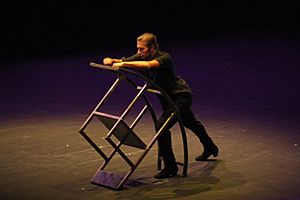Israel Galván facts for kids
Israel Galván Reyes (born in Seville in 1973) is a famous Spanish flamenco dancer and choreographer. He learned to dance from a young age. His father, José Galván, and his mother, Eugenia Reyes, were both dancers.
Israel became well-known for his amazing footwork. His dancing includes very fast and complex steps. He also uses moments of stillness and quiet. His unique style is often called avant-garde flamenco. This means it's new and different. He has won many important dance awards.
Contents
Israel Galván's Career Journey
Early Steps and Awards
- In 1994, Israel joined the Compañia Andaluza de Danza. This was a dance company led by Mario Maya.
- Over the next ten years, he won almost every major flamenco award.
- These included the Giradillo prize at Seville's flamenco Biennal.
- He also won the Flamenco Hoy critics’ award for best dancer. He received this award in both 2001 and 2005.
- In 2005, he won Spain's national dance prize. This was for bringing new ideas to flamenco.
- In 2008, he received the Premio Ciutat de Barcelona.
Creating His Own Works
- Israel Galván started his own dance company in 1998.
- His first show with his company was called Mira Los Zapatos Rojos.
- He became known for taking risks with his art. Each new show was more surprising.
- Some of his famous works include Metamorphosis, which was a flamenco version of a story by Kafka.
- Arena was a dramatic show about bullfighting.
- La Edad de Oro explored traditional flamenco.
- Tabula Rasa offered a new way of looking at flamenco.
- Solo was his most experimental show. In this piece, silence was as important as music.
- He also created El Final de este estado de cosas redux. This show premiered in Seville in 2008.
Working with Other Artists
- Israel Galván has worked with many artists.
- He has collaborated with classic flamenco singers and musicians. These include Fernando Terremoto and Inés Bacan.
- He also worked with modern flamenco artists. Some of these are Enrique Morente and Miguel Poveda.
- He often brings together different styles of music in his shows.
Important and Thought-Provoking Shows
- In 2013, Israel Galván created a show called Lo Real/ Le Réel/ The Real.
- This performance was about a difficult historical event. It explored the suffering of the Romani people during a very hard time.
- The show received a standing ovation in Amsterdam. However, some people in Madrid had a more mixed reaction.
- Galván's performance was very intense. He used his body to express strong emotions. He even changed his physical appearance for the show. He wanted to show the struggle and resilience of the victims.
- In 2014, a new show called Torobaka premiered in Madrid.
- Israel Galván performed this show with Akram Khan. Khan is a dancer and choreographer from England.
- The show's name combines Spanish words for "bull" (toro) and "cow" (vaca). This hinted at different cultures.
- The music for Torobaka was a mix of many styles. It included old church songs and Hindu music.
- Also in 2014, Israel Galván presented FLA.CO.MEN.
- This show was described as a concert.
- In FLA.CO.MEN, Galván took flamenco apart and put it back together in a funny way.
- The music was a mix of traditional flamenco and experimental jazz.
Awards and Recognition
- Premios Max are Spain's most important theater awards.
- In 2014, Israel Galván won three Premios Max for Lo Real. He won for Choreography, Performance, and Best Show.
- In 2015, he won another Premios Max for Best Male Dancer in FLA.CO.MEN.
- On May 6, 2017, Israel Galván premiered La Fiesta in Austria. This show brought together nine dancers and singers.
- In 2021, Israel Galván shared that he always wanted to be a dancer.
- He remembered the "smell of the night" from his first flamenco show as a child.
Awards and Honors
Israel Galván has received many awards for his incredible talent:
- 2023: Critics' Circle National Dance Award: Outstanding Male Modern Performance
- 2016: Critics' Circle National Dance Award: Special award for exceptional artistry
- 2015: Medalla de Andalucía (Medal of Andalusia)
- 2015: Ordre des Arts et des Lettres (Order of Arts and Letters, France)
- 2015: Premios Max
- 2015: UNESCO designation for the Official Manifesto of International Dance Day
- 2012: Medalla de oro de las Bellas Artes (Gold Medal of Fine Arts)
- 2012: Bessie Award (USA)
- 2009: Gran Prix de la Danse (Grand Prize of Dance)
- 2008: Giraldillo
- 2007: Premio Ciutat de Barcelona Dansa (Barcelona City Dance Award)
- 2005: Premio Nacional de Danza (National Dance Award)
- 2001: Premio Flamenco
- 1996: Premio Desplante
See also
 In Spanish: Israel Galván para niños
In Spanish: Israel Galván para niños

All content from Kiddle encyclopedia articles (including the article images and facts) can be freely used under Attribution-ShareAlike license, unless stated otherwise. Cite this article:
Israel Galván Facts for Kids. Kiddle Encyclopedia.

